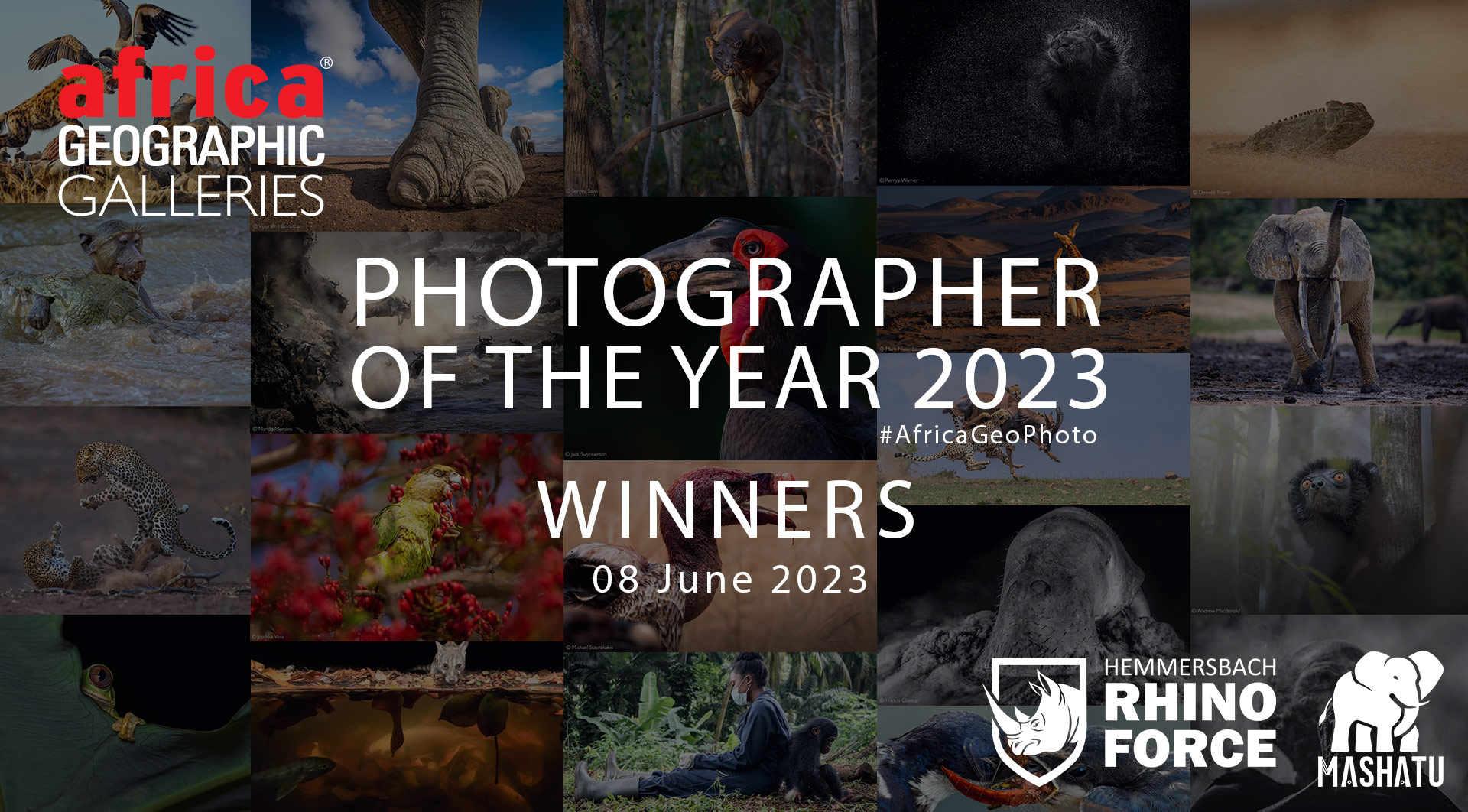
Photographer of the Year 2023 Winners


Ladies and gentlemen, prepare to be dazzled as we unveil the highly anticipated winners of our prestigious Photographer of the Year 2023 competition! After careful consideration, we are thrilled to reveal the talented individuals who have best captured the essence of Africa through their extraordinary photographs.
The winner and two runners-up will share the impressive $10,000 prize money, and they and their partners will join our CEO Simon Espley and his wife, Lizz, on the ultimate private safari in the wilderness paradise of Botswana.
We would like to thank our generous sponsors, Hemmersbach Rhino Force and Mashatu Botswana, whose support has been invaluable.
A note from our CEO:
This year found us enjoying more high-quality entries in the final selection month than ever before, and this final selection of the winners was a particularly tough one. This gallery of our winners emphasises the gobsmackingly awesome biodiversity of this place. Just wow!
What stood out for us this year was how well our entrants captured movement (sometimes in poor light), and this year we decided to select our top three entries based on that aspect of photography. We don’t decide these things beforehand; each year, the entries lead us down different paths of celebration.
Lastly, a word about the use of artificial intelligence (AI) to enhance and generate photos: we suspect that AI will dominate all photographic competitions going forward – including the submission of computer-generated images – and so we will need to change how we manage our selection process. We have no interest in permitting computer-generated images into our space, but using AI to enhance images is another story. AI will become as much a part of photo editing as Photoshop is now, and it’s up to us to draw firm lines in the sand if we are to continue celebrating authentic photography. Technology-driven change is a constant in this industry, some good and some bad. It is what it is; we will keep working hard to deliver on our promise of celebrating Africa (the real Africa) and doing good. On that note, every photographer in this Winner’s gallery submitted RAW photographic files for our inspection.
Congratulations to every photographer that made it through thousands of entries to appear in our weekly selections, Top 101, Finalists and these Winners. Thanks for trusting us with your beautiful work, and please keep the flag of authentic photography flying high. See you again in 2024!

WINNER – PHOTOGRAPHER OF THE YEAR 2023

Judges’ comment:
Capturing this big male lion shaking his mane in such sharp focus is no mean feat. The challenges of rapid movement and early morning light are met with great skill, and the excellent post-production edits create a dramatic yet moody image worthy of our award. The backlit halo of water droplets creates an otherworldly effect.
Photographer and photo details – read more
“‘It’s all about learning to dance in the rains.’ At the line of the equator at an altitude of over 5,000 ft (1,534 m), the Mara rains create a captivating display of water and sun, blending together in a vibrant tapestry of light and shade. This breathtaking phenomenon is rarely witnessed elsewhere but is unknown to many who avoid visiting during the monsoon season. On that particular day, dark rain clouds were gathering, and we decided to venture out in search of male lions as they presented our best photographic opportunity. Fortunately, the Black Rock lion pride had been spotted near our camp earlier that day. We quickly located the pride, consisting of a dozen lions, including two males and a few cubs. The next step involved waiting patiently, peering through the viewfinder in anticipation of capturing the golden moment when the lions would shake off the water from their manes. It was crucial to find an angle with a dark background for the composition, as only against such a backdrop could the flying droplets of water gleam like stars. By utilising a higher shutter speed, I was able to freeze those airborne, luminous droplets, resulting in the captivating image presented here.”
About photographer Remya Warrier
 Remya Warrier is a passionate wildlife photographer, naturalist and conservationist hailing from Kerala, India. She completed her wildlife field guiding course in Botswana’s Mashatu Game Reserve in 2018. Her childhood love of wildlife has taken her to various biodiversity hotspots around the world. Remya was settled in Singapore and used to conduct nature walks and talks for kids and adults, spreading flora & fauna knowledge among them. She, along with her husband & friends, also set up a farm in India. There she established afforestation projects that have restored natural water cycles and seen the return of several bird species. In 2021, Remya moved to Maasai Mara, Kenya, to pursue her passion for wildlife photography and conservation initiatives. She also co-founded Rhino Lovers NGO & Osero Sopia River Camp, Maasai Mara, Kenya.
Remya Warrier is a passionate wildlife photographer, naturalist and conservationist hailing from Kerala, India. She completed her wildlife field guiding course in Botswana’s Mashatu Game Reserve in 2018. Her childhood love of wildlife has taken her to various biodiversity hotspots around the world. Remya was settled in Singapore and used to conduct nature walks and talks for kids and adults, spreading flora & fauna knowledge among them. She, along with her husband & friends, also set up a farm in India. There she established afforestation projects that have restored natural water cycles and seen the return of several bird species. In 2021, Remya moved to Maasai Mara, Kenya, to pursue her passion for wildlife photography and conservation initiatives. She also co-founded Rhino Lovers NGO & Osero Sopia River Camp, Maasai Mara, Kenya.
Social: @warrier_remya
RUNNERS-UP
(in no specific order)
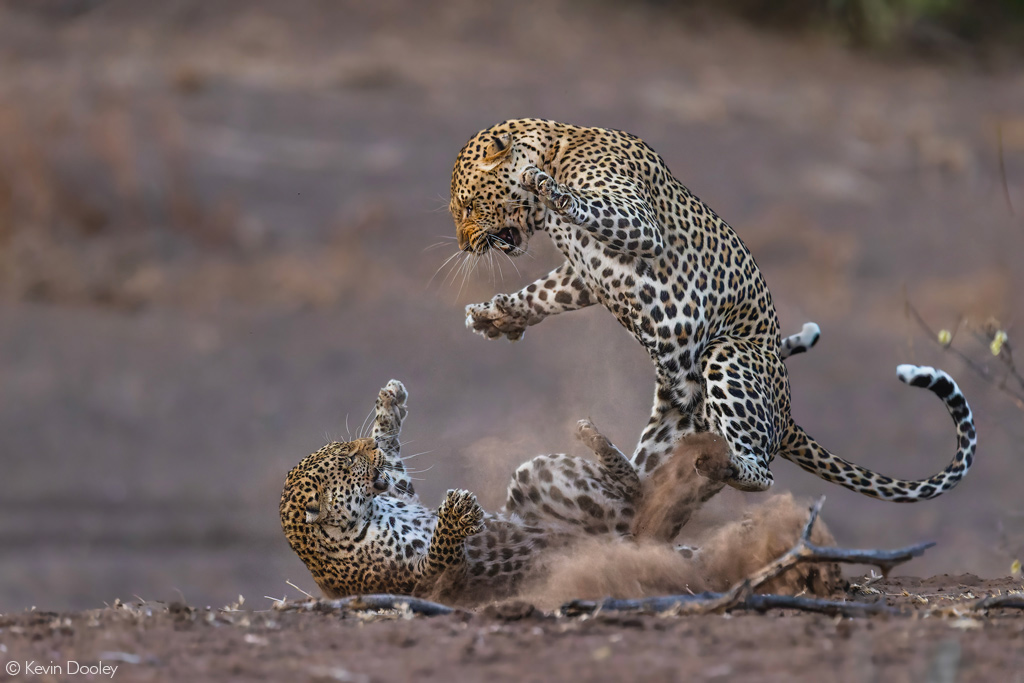
Judges’ comment:
This is the leopard picture that everyone wants to get – that split-second after mating when the male bounces away to avoid the inevitable backlash. The low angle, shallow depth of field and sharp focus capture the moment perfectly and emphasise that unique leopard ability to exude power and grace simultaneously.
Photographer and photo details – read more
“I located these leopards in a tree during the mid-morning. While in the tree, the female leopard would approach the male and nudge him to initiate mating. However, he showed no interest in her. Returning later, I waited for the leopards to descend the tree. After a few hours, they began to show signs of getting active. I had photographed this male leopard before and recognised him as a younger individual. Shortly the leopards began the mating ritual. However, the male’s inexperience seemed to exacerbate their confrontation, and the action and expression were quite intense. Capturing this image was challenging as the light was fading quickly. I used a 2.8 aperture and higher ISO to maintain a fast shutter speed. This image was selected and presented to the president of Botswana from the safari lodge and reserve where it was taken.”
About photographer Kevin Dooley
 Kevin Dooley, an award-winning Wildlife and Portrait/Wedding Photographer from Placitas, New Mexico, discovered his passion for photography at age 14 when he received a 35mm camera as a gift. He holds a photographic craftsmen’s degree, a master’s degree, and the prestigious imaging excellence award from the Professional Photographers of America’s degree program. Starting as an assistant and darkroom technician in his father’s portrait studio, Kevin embarked on a lifelong photography career. After serving in the US Navy, he established his own photography studio in Albuquerque, which garnered numerous awards and publications over its 40-year operation until its recent retirement. Africa holds a special place in Kevin’s heart, and he enjoys sharing its wonders with others, teaching about wildlife, trees, and the region’s history. He is also a compassionate humanitarian who uses photography to inspire and foster a love for life and nature.
Kevin Dooley, an award-winning Wildlife and Portrait/Wedding Photographer from Placitas, New Mexico, discovered his passion for photography at age 14 when he received a 35mm camera as a gift. He holds a photographic craftsmen’s degree, a master’s degree, and the prestigious imaging excellence award from the Professional Photographers of America’s degree program. Starting as an assistant and darkroom technician in his father’s portrait studio, Kevin embarked on a lifelong photography career. After serving in the US Navy, he established his own photography studio in Albuquerque, which garnered numerous awards and publications over its 40-year operation until its recent retirement. Africa holds a special place in Kevin’s heart, and he enjoys sharing its wonders with others, teaching about wildlife, trees, and the region’s history. He is also a compassionate humanitarian who uses photography to inspire and foster a love for life and nature.
Social: @kevindooley_idubephotosafaris
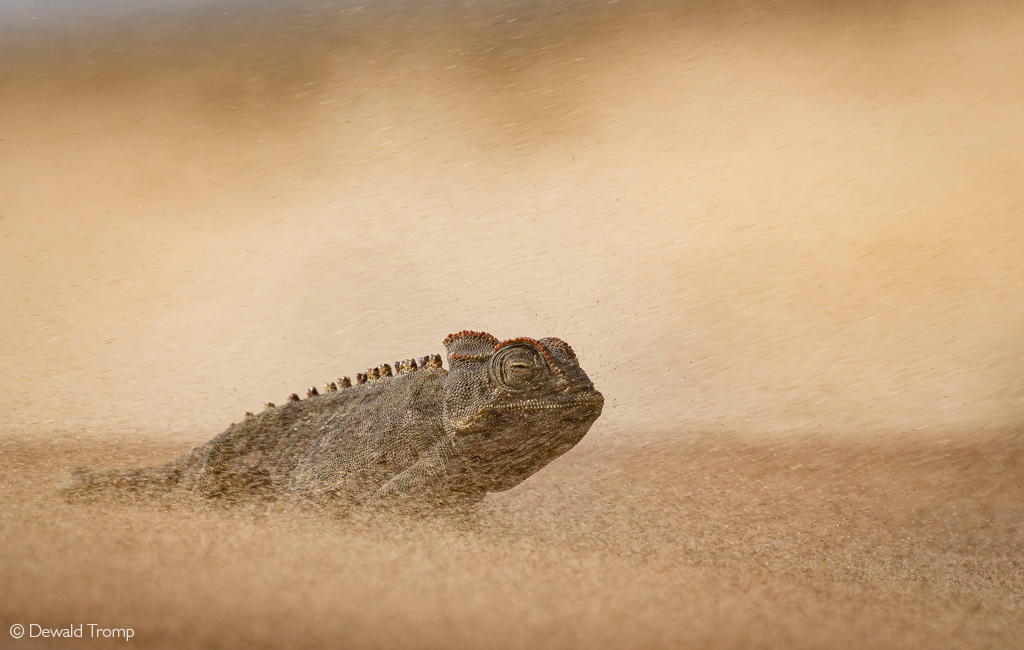
Judges’ comment:
Few will get to encounter a desert-adapted chameleon in a sandstorm – let alone capture the moment perfectly. The horizontally propelled sand particles ricocheting off the grimacing, slit-eyed reptile creates the scene, and the shallow depth of field and sharp focus do the rest. To lie down to achieve the low-level perspective in a sand storm that could damage your equipment speaks to the authentic journey of a passionate wildlife photographer
Photographer and photo details – read more
“The Namib desert is one of the most extreme environments on Earth, with a complete lack of surface water and temperatures exceeding 45˚C in the daytime. Despite this, life is abundant if you know where to look. Sandstorms are frequent, with winds blowing down from inland mountains that stir up fine sediment and particles. A Namaqua chameleon has to endure the sting of the sand pebbles blowing against its skin while we were lucky enough to escape to the relative comfort of our 4×4.”
About photographer Dewald Tromp
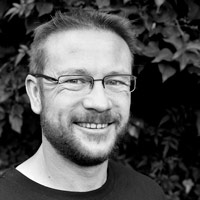 Originally from Windhoek, Namibia, Dewald grew up in a small rural town called Belfast, Mpumalanga. As a child, all his family holidays were spent in the Kruger National Park or camping or hiking. This is where his love for nature was cultivated. Although he works in the medical field, wildlife photography has been his passion for the last 20 years. Dewald and his wife have travelled extensively around the globe to photograph rare and interesting wildlife. Through his images, he would like to influence people to start thinking about conservation and protecting the last remaining wild places on Earth.
Originally from Windhoek, Namibia, Dewald grew up in a small rural town called Belfast, Mpumalanga. As a child, all his family holidays were spent in the Kruger National Park or camping or hiking. This is where his love for nature was cultivated. Although he works in the medical field, wildlife photography has been his passion for the last 20 years. Dewald and his wife have travelled extensively around the globe to photograph rare and interesting wildlife. Through his images, he would like to influence people to start thinking about conservation and protecting the last remaining wild places on Earth.
Social: @dewald.tromp.9

HIGHLY COMMENDED
(in no specific order)

Judges’ comment:
The moment of bliss as this old soul fills his lungs is well-captured. We can almost smell the smoke and feel the sensual overload as he is transported into a relaxed state. The low angle and shallow depth of field create distance between him and us; the portrait does not seem to be at the expense of his personal space.
Photographer and photo details – read more
“We had sat down for a rest one afternoon under the shade of some trees while on our walk, and this San elder took out what I first thought was a pipe. It turned out to be his smoking apparatus, and upon closer inspection, it was an old artillery shell. He had just danced himself into a trance last night before passing out, and I was curious if it had something to do with what he was smoking. We swapped, and I took a puff. It was nothing I was familiar with, but it didn’t have any expected effects – it was natural and slightly herbal. We had spent two nights with this San tribe in Xai Xai to understand their lives in modern Botswana better and to experience a taste of what it used to be like. This photograph was taken on Expedition Kalahari, as part of a trilogy on Botswana’s three habitats: the Okavango Delta, the Makgadikgadi Salt Pans and the Kalahari Desert.”
About photographer Alwyn Chong
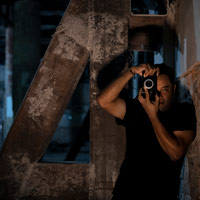 Alwyn Chong is a photographer based in Singapore, where he also shoots for Leica Camera. He has a passion for black and white photography, and his motivations extend to storytelling through his photographs. He is a self-published photographer of two books: “Odyssey ‘Picturing and Imaging the Okavango Delta'” and “Finding the Other Side, Horizons Upon the Makgadikgadi” which document his expeditions in Botswana (a country that holds a special place in his heart).
Alwyn Chong is a photographer based in Singapore, where he also shoots for Leica Camera. He has a passion for black and white photography, and his motivations extend to storytelling through his photographs. He is a self-published photographer of two books: “Odyssey ‘Picturing and Imaging the Okavango Delta'” and “Finding the Other Side, Horizons Upon the Makgadikgadi” which document his expeditions in Botswana (a country that holds a special place in his heart).
Social: @alwyn.chong

Judges’ comment:
There are about 125 mature Perrier’s sifaka left in the wild – making this critically endangered primate the rarest lemur on Earth. As if the task of finding one is not challenging enough, the photographer overcame bright sky, jet-black lemur fur and poor woodland light to create this evocative image of a sifaka seeming to peer out of the abyss of its conservation status.
Photographer and photo details – read more
“This image was captured in the forests of Anjahakely, northeast Madagascar. The hope for the day was to locate and photograph the critically endangered Perrier’s sifaka, not an easy task with an estimated 125 mature individuals left in the wild. Luckily, with the help of local guides, I found them and started shooting. Let me tell you, photographing such dark animals while looking up into a bright forest canopy is not easy. Eventually, after following the lemurs through the rough terrain, one stayed still long enough for me to capture this shot. I loved how the sifaka looked up into the light breaking through the canopy high above. Amazingly we both held still long enough for me to shoot this at a shutter speed of 1/80 of a second, adjusting my ISO to compensate for the dark forest. A matter of seconds after this shot, it had bounded through the trees and was at least 50 metres away. A memorable day in the wilds of Madagascar.”
About photographer Andrew Macdonald
 Andrew Macdonald is a freelance photographer and videographer from Scotland who currently resides in Cape Town. He is passionate about all things wildlife and nature, and he hopes that viewers of his work can see the photos and feel them, too, as he tries to capture the most emotive moments. His photography has taken him from his small hometown village in Scotland all the way to the South Pole, and he is always ready for an adventure with his camera in hand.
Andrew Macdonald is a freelance photographer and videographer from Scotland who currently resides in Cape Town. He is passionate about all things wildlife and nature, and he hopes that viewers of his work can see the photos and feel them, too, as he tries to capture the most emotive moments. His photography has taken him from his small hometown village in Scotland all the way to the South Pole, and he is always ready for an adventure with his camera in hand.
Social: @a_mac_photo
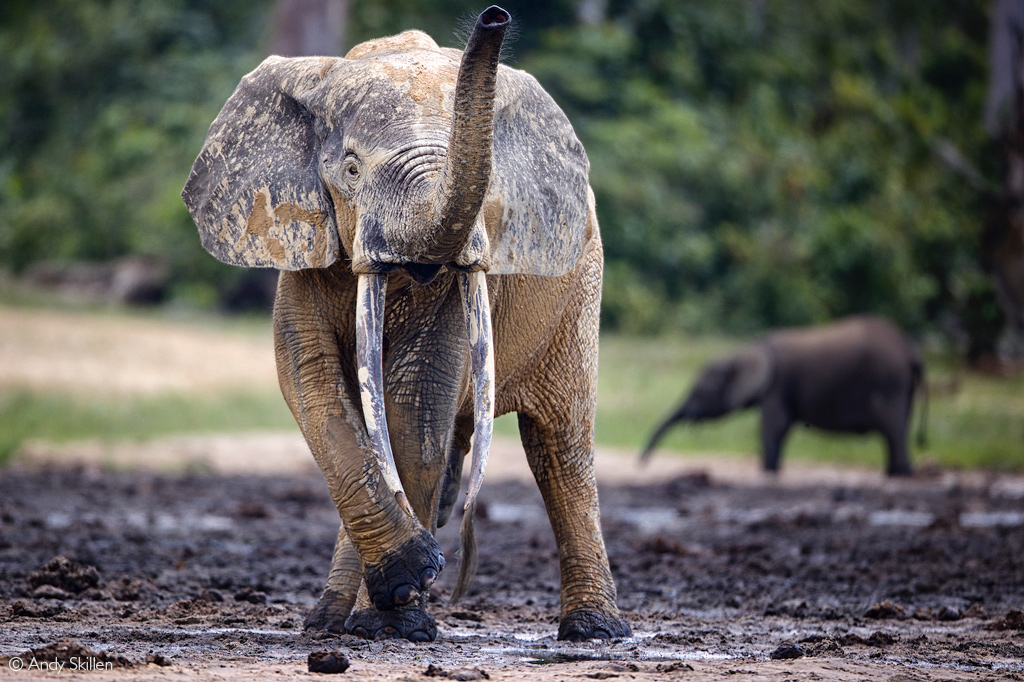
Judges’ comment:
This layered chocolate cake forest elephant in the middle of a muddy baï seems caught in a moment of indecision. The whiff of humans has triggered a silent alarm, but the protection of cover is some way off. The photographer has perfectly captured the body language of this secretive giant of the dense, gloomy rainforest
Photographer and photo details – read more
Dzanga Baï is one of the most famous gathering places for elephants anywhere on the continent, if not worldwide. This enormous clearing, located deep in the heart of the seemingly impenetrable Central African forest, can be occupied by up to 150 elephants per day as they amble from the surrounding forests into the baï to mine for minerals, paint themselves in the varying tones of earth that are all around the clearing, and socialise. Mining is a key part of the daily ritual for forest elephants, fulfilling a dietary niche, and baïs such as Dzanga are essential in allowing this activity to occur in peace. Whilst photographing the region for an upcoming book, I had the privilege to work there for a couple of weeks and witness the comings and goings of these gentle giants from ground level…some a bit more curious than others!
About photographer Andy Skillen
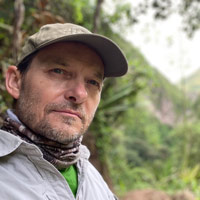 Andy Skillen has been a wildlife photographer and photojournalist for nearly 30 years, covering natural history on all continents. In addition to books and magazine articles, Andy supplies fine art limited edition prints to collectors worldwide and engages in talks and trip-leading on an international basis. Andy’s passion is conservation, and as such hopes that the places he visits, documents and reports on inspire others to see the wonder in the wild that surrounds them and step up to take an active part in its preservation.
Andy Skillen has been a wildlife photographer and photojournalist for nearly 30 years, covering natural history on all continents. In addition to books and magazine articles, Andy supplies fine art limited edition prints to collectors worldwide and engages in talks and trip-leading on an international basis. Andy’s passion is conservation, and as such hopes that the places he visits, documents and reports on inspire others to see the wonder in the wild that surrounds them and step up to take an active part in its preservation.
Social: @andyskillenphoto
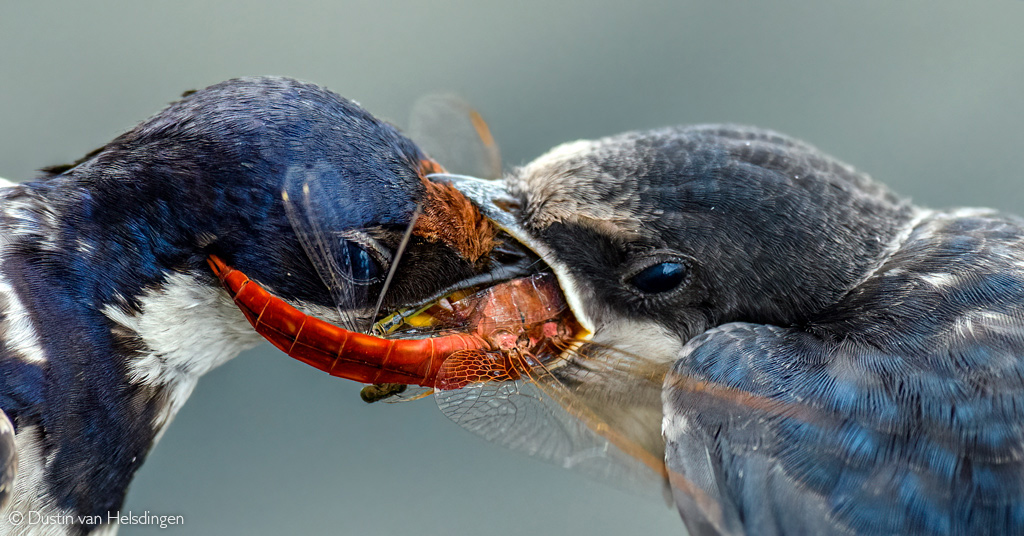
Judges’ comment:
This photograph had us marvelling at how much food can be stuffed into the gaping maw of such a tiny bird – rigid carapace, wings and all! But also about how hard the parents work to fledge their broods. An excellent natural history portrayal that makes us appreciate less popular photographic subjects!
Photographer and photo details – read more
“After a long morning self-drive in Pilanesberg National Park, I decided to stretch my legs and visit Mankwe Hide. This hide, located on the western edge of Mankwe Dam, provides great opportunities for photographing birds and other wildlife. While standing in the hide, I heard the familiar noises of chicks begging for food and found two juvenile white-throated swallows perched on a support beam. They were in an awkward position, the difficult angle making it challenging to maintain stability and focus. Luckily, I did not have to wait long as one of the parents swooped down, resulting in a flurry of movement. I was not sure if I managed to get the shot, but I was delighted when viewing the results on the back camera screen. What a surprise to see the size of the dragonfly caught and fed to the chick!”
About photographer Dustin Van Helsdingen
 Dustin, a 39-year-old nature and wildlife enthusiast based in Rustenburg, South Africa, discovered his passion for wildlife photography in 2014 when his wife gifted him a DSLR camera for his birthday trip to a private game reserve. Since then, he has been captivated by the world of nature and wildlife. Regular visits to game reserves have provided him with countless opportunities to observe and capture the behaviour of animals, granting him a deeper understanding and unique perspective of their world. It’s not just about the iconic Big 5; Dustin has developed a newfound appreciation for the beauty of landscapes, trees, insects, and all living things. Through his lens, he perceives the world with a new lens (excuse the pun!).
Dustin, a 39-year-old nature and wildlife enthusiast based in Rustenburg, South Africa, discovered his passion for wildlife photography in 2014 when his wife gifted him a DSLR camera for his birthday trip to a private game reserve. Since then, he has been captivated by the world of nature and wildlife. Regular visits to game reserves have provided him with countless opportunities to observe and capture the behaviour of animals, granting him a deeper understanding and unique perspective of their world. It’s not just about the iconic Big 5; Dustin has developed a newfound appreciation for the beauty of landscapes, trees, insects, and all living things. Through his lens, he perceives the world with a new lens (excuse the pun!).
Social: @dustin.vanhelsdingen
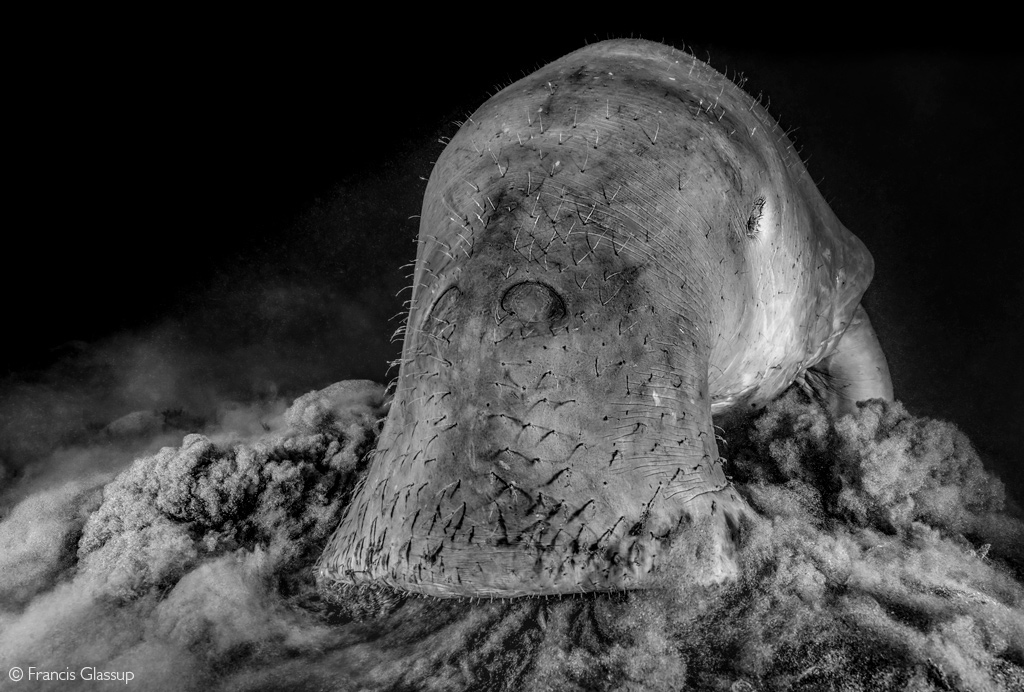
Judges’ comment:
The swirling mud and choice of black & white combined with the front-on, low-down perspective grabbed the eyes and left us pondering—a marvellous portrayal of this threatened and seldom-seen gentle creature of the seas
Photographer and photo details – read more
“‘ Critically endangered.’ Once a common sight around Africa, dugong populations have drastically declined due to seagrass habitat loss, human pressure, and the potentially devastating impacts of climate change on their main food source. Thankfully, the Lagoons of Abu Dabbab in Egypt still offer refuge for a few of these majestic sea creatures. In August 2022, I had the incredible opportunity to observe a large male dugong feeding in the area. After hours of studying its behaviour, I positioned myself to capture an image showcasing its raw power and beauty as it vacuumed up seagrass amongst the billowing sediment clouds.”
About photographer Francis Glassup
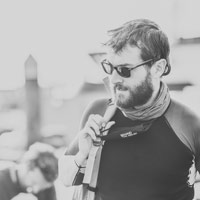 Francis Glassup, a graduate in Oceanography from the University of Plymouth in the UK, is an accomplished underwater photographer whose works have garnered recognition in several underwater photography competitions. With a deep affinity for the ocean, Francis finds solace and fulfilment beneath the surface, capturing captivating moments as he patiently awaits the unexpected. Through his photography, he aspires to raise awareness about the imperative need for robust conservation efforts to protect our precious oceans.
Francis Glassup, a graduate in Oceanography from the University of Plymouth in the UK, is an accomplished underwater photographer whose works have garnered recognition in several underwater photography competitions. With a deep affinity for the ocean, Francis finds solace and fulfilment beneath the surface, capturing captivating moments as he patiently awaits the unexpected. Through his photography, he aspires to raise awareness about the imperative need for robust conservation efforts to protect our precious oceans.
Social: @francisglassup

Judges’ comment:
So, how many words is a picture worth? This poignant photograph has a specific raison d’être – to generate international awareness and support for the plight of Central Africa’s primates. The onslaught of poaching for bushmeat, muti and the pet trade threaten the remaining populations of great apes and other primates. We think the photographer has succeeded admirably in his mission.
Photographer and photo details – read more
“Bakossi, a Nigeria-Cameroon chimpanzee (Pan troglodytes ellioti), explores her surroundings with curiosity in the comforting presence of her dedicated caregiver, Queen. Orphaned chimpanzees, like Bakossi, require intensive care and compassion to recover from the trauma of losing their mothers. Shockingly, for every infant chimpanzee captured alive, an estimated 5-10 chimpanzees are killed in the wild. Queen is part of the team at Limbe Wildlife Centre, a rescue and rehabilitation centre focusing on the unique species of Cameroon. With 30 years of experience, the centre provides love and commitment to help traumatised chimpanzees build trust and embark on their rehabilitation journey. Currently, the Limbe Wildlife Centre cares for 41 chimpanzees, 14 western lowland gorillas, 67 drills, and more.”
About photographer Gerard Carbonell
 Gerard Carbonell, born in Barcelona in 1999, is a biologist and dedicated conservation photographer. Through his captivating images, Gerard endeavours to deepen our comprehension of the natural world and our intricate connection with it. His primary objective as a photographer is to raise awareness about the significance of biodiversity and its habitats, shedding light on the commendable efforts undertaken by various organisations and local communities to protect them. Gerard’s compelling visual narratives aim to instil a sense of urgency among people, encouraging support for conservation initiatives.
Gerard Carbonell, born in Barcelona in 1999, is a biologist and dedicated conservation photographer. Through his captivating images, Gerard endeavours to deepen our comprehension of the natural world and our intricate connection with it. His primary objective as a photographer is to raise awareness about the significance of biodiversity and its habitats, shedding light on the commendable efforts undertaken by various organisations and local communities to protect them. Gerard’s compelling visual narratives aim to instil a sense of urgency among people, encouraging support for conservation initiatives.
Social: @geri_carbonell

Judges’ comment:
The photographer’s journey to achieve the desired result you see here is what makes this an epic capture. Hannes (our 2021 Photographer of the Year) combines detailed planning, patience, the right equipment and exceptional technical skill to tell the story of a small waterhole in a South African private game reserve.
Photographer and photo details – read more
“After months of monitoring the waterhole, I noticed the spotted genet’s interest in the fish underwater. To capture this moment, I placed a camera in a homemade waterproof housing and triggered the camera from a distance. I utilised three different light sources: a soft light for underwater and two bounce sidelights. I worked on this particular image for a few years: photographs like this need a lot of planning, and you need to know exactly where, when, and how long these animals are in the area. Then, they must do exactly what you hope they will do. That’s why it took me quite a few years to get this image.”
About photographer Hannes Lochner
 Hannes Lochner is an acclaimed wildlife photographer with over 15 years of experience. He has produced five stunning photographic books, three focusing on the Kalahari. Hannes dedicated six years of his life to living in the Kalahari and spent hundreds of hours capturing mesmerising images of its unique landscape and enigmatic inhabitants. He then ventured to Botswana’s Okavango Delta, spending two and a half years there with his wife, Noa, who handles the filming for their projects. Hannes is working on his sixth publication, “Once Upon a Time.” The image provided is the cover of his upcoming book, set to be published this year.
Hannes Lochner is an acclaimed wildlife photographer with over 15 years of experience. He has produced five stunning photographic books, three focusing on the Kalahari. Hannes dedicated six years of his life to living in the Kalahari and spent hundreds of hours capturing mesmerising images of its unique landscape and enigmatic inhabitants. He then ventured to Botswana’s Okavango Delta, spending two and a half years there with his wife, Noa, who handles the filming for their projects. Hannes is working on his sixth publication, “Once Upon a Time.” The image provided is the cover of his upcoming book, set to be published this year.
Social: @hannes_lochner
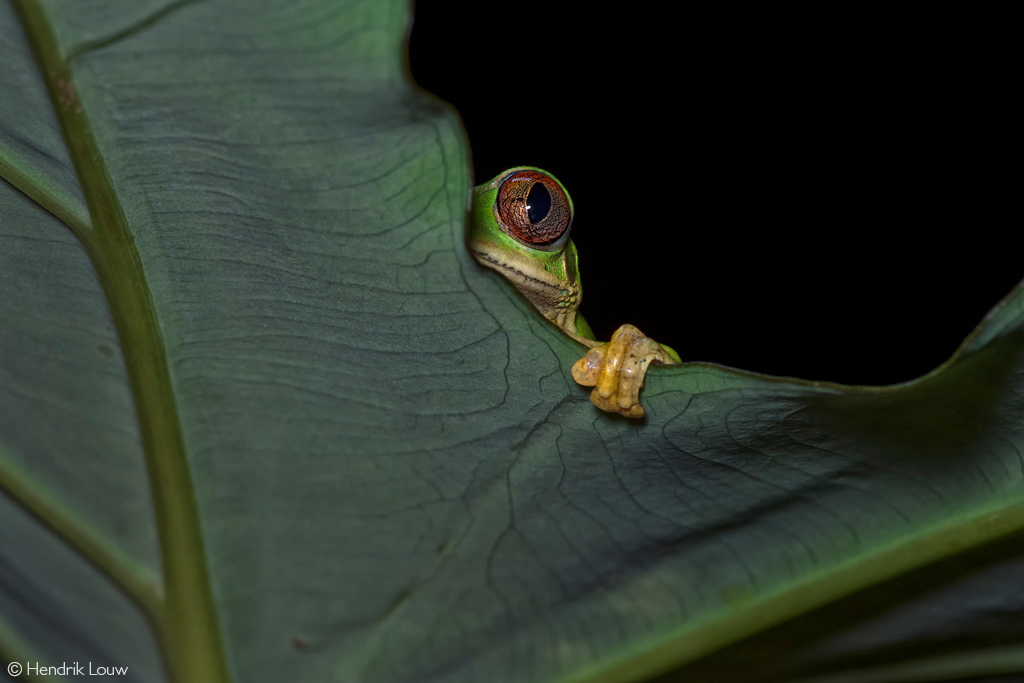
Judges’ comment:
Less is more. Tree frogs make delightful photographic subjects, and we receive many fantastic entries displaying them in various poses and locations. This entry stood out for us because the peering frog creates the impression of a show about to start – of actors gathered nervously behind the curtains, peering out at the hushed, expectant audience.
Photographer and photo details – read more
“During our visit to Durban in December 2022, we enjoyed staying near a small stream. I had hoped to spot a little forest tree frog in the area. I could hear their calls every night, but they remained elusive in the treetops. One rainy night, I ventured out and diligently searched until I found a couple of frogs to photograph. Two days later, just after sunset, I spotted this particular frog (having a rough idea of its hiding spot) and seized the opportunity to capture this unique photo. The frog was quite shy, as it was still early evening, creating the perfect conditions for this shot. While they blend seamlessly into their daytime surroundings, these frogs come alive at night, vocally announcing their presence and showing no fear of human scrutiny.”
About photographer Hendrik Louw
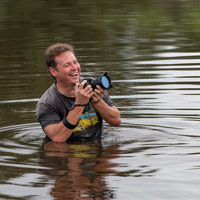 Hendrik has been an amateur photographer for the last 24 years and still enjoys it to its fullest extent. His love for photography started with a second-hand camera in 1999 when he joined a photographic club. He enjoys all genres of photography, but his real passion is macro photography. Frogs, mantises, and spiders tend to visit his camera fairly often when in the right environment since he is madly in love with these colourful little creatures. He is also one of the few macro photographers playing with alternative techniques such as wide-angle macro. His macro photography has earned many achievements, including several awards in multiple international photographic competitions. Despite being an amateur, he enthusiastically shares his passion through workshops and participation in photographic congresses. Outside of photography, Hendrik is an environmental manager and climate change specialist.
Hendrik has been an amateur photographer for the last 24 years and still enjoys it to its fullest extent. His love for photography started with a second-hand camera in 1999 when he joined a photographic club. He enjoys all genres of photography, but his real passion is macro photography. Frogs, mantises, and spiders tend to visit his camera fairly often when in the right environment since he is madly in love with these colourful little creatures. He is also one of the few macro photographers playing with alternative techniques such as wide-angle macro. His macro photography has earned many achievements, including several awards in multiple international photographic competitions. Despite being an amateur, he enthusiastically shares his passion through workshops and participation in photographic congresses. Outside of photography, Hendrik is an environmental manager and climate change specialist.
Social: @hempieslouw

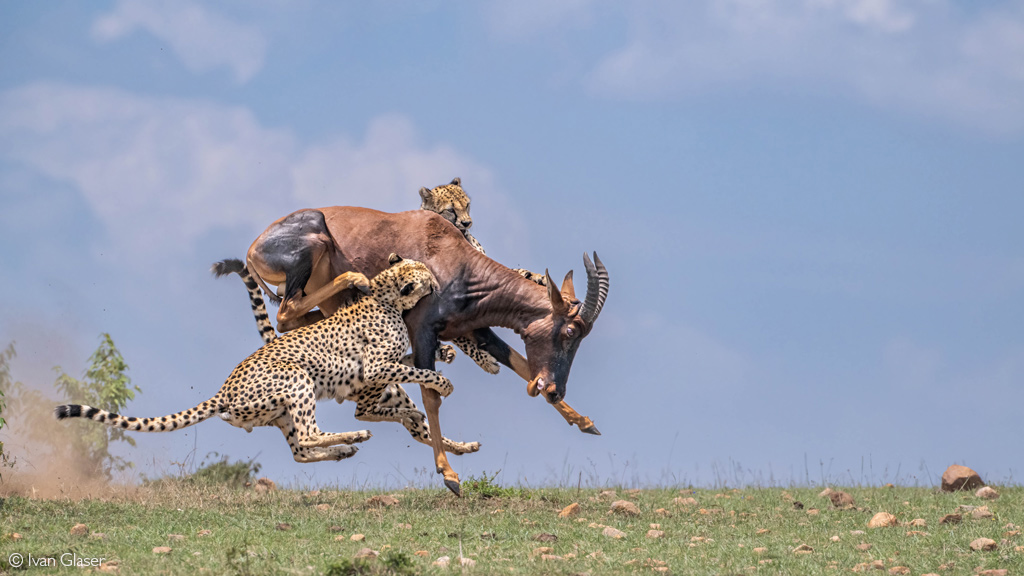
Judges’ comment:
Who doesn’t like a great predation action photograph? This, too, is a popular theme amongst entries to Photographer of the Year, and for us, there has to be more than blood and crazy eyes. The photographer caught this fast-moving moment perfectly, as the large male topi fights for its life, and the cheetah coalition males combine forces to bring him down.
Photographer and photo details – read more
“These cheetahs are part of the renowned “Tano Bora” coalition, originally consisting of five cheetahs, and we were closely monitoring them as their hunting skills are legendary in the Maasai Mara. On this day, a lone topi approached the cheetahs, triggering their swift transition into hunting mode. While camera settings and tracking skills are important, understanding animal behaviour and terrain is crucial for success. Our guide, Jackson Ronko, skilfully positioned us about 150m away, anticipating the hunt’s trajectory along the ridge line. The cheetahs chased the topi against the backdrop of a clear sky and successfully made their kill. The image captures the moment when the cheetahs brought down the topi, showcasing their hunting prowess to bring down such large prey. Overall, the experience highlighted the importance of knowledgeable guides like Jackson, who can anticipate animal behaviour and position photographers for incredible opportunities.”
About photographer Ivan Glaser
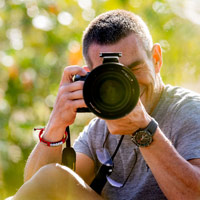 Ivan was born into a family of wildlife and photography enthusiasts in South Africa, where his deep passion for African wildlife and wildlife photography took root at an early age. Sharing this passion through his photography has always brought him joy. In his mid-twenties, Ivan emigrated to Australia and began his corporate career. During those years, his focus shifted away from wildlife and photography as his professional responsibilities and family took precedence. However, in 2019 an extraordinary opportunity presented itself when Ivan joined an Africa Geographic photo safari to the Maasai Mara. Under the expert guidance of renowned Norwegian wildlife photographer Arnfinn Johansen and in the welcoming embrace of Oltepesi Tented Safari Camp, Ivan’s wildlife photography skills radically transformed, reaffirming his love for Africa. Now in retirement, he is wholeheartedly pursuing his lifelong passion for wildlife and wildlife photography. Ivan continues to make regular trips back to the Maasai Mara, hosting guided safaris for small groups of fellow wildlife and photography enthusiasts who share his love for the natural world.
Ivan was born into a family of wildlife and photography enthusiasts in South Africa, where his deep passion for African wildlife and wildlife photography took root at an early age. Sharing this passion through his photography has always brought him joy. In his mid-twenties, Ivan emigrated to Australia and began his corporate career. During those years, his focus shifted away from wildlife and photography as his professional responsibilities and family took precedence. However, in 2019 an extraordinary opportunity presented itself when Ivan joined an Africa Geographic photo safari to the Maasai Mara. Under the expert guidance of renowned Norwegian wildlife photographer Arnfinn Johansen and in the welcoming embrace of Oltepesi Tented Safari Camp, Ivan’s wildlife photography skills radically transformed, reaffirming his love for Africa. Now in retirement, he is wholeheartedly pursuing his lifelong passion for wildlife and wildlife photography. Ivan continues to make regular trips back to the Maasai Mara, hosting guided safaris for small groups of fellow wildlife and photography enthusiasts who share his love for the natural world.
Website: https://madaboutmara.com

Judges’ comment:
Two things stand out for us about this photo. Firstly, the clarity around the eye of the ground-hornbill. We optimise images for web purposes but rest assured that this image is crystal clear. Secondly, the subject matter – any bird eating a tortoise is an eye-opener for most people, and seeing the tortoise all mushed up in the hornbill vice-grip brings home the message of the ruthless cycle of life.
Photographer and photo details – read more
“As the sun set over the Okavango, I was pressed for time. With Fabio as my guide, we ventured out from Duke’s Camp, aware that daylight was fading fast. In the marshland of the Delta, we unexpectedly came across a group of southern ground-hornbills. Amidst them, I spotted a striking solitary individual perched on a withered branch, its vibrant red collar contrasting with its dark feathers. Seizing the moment, I brought out my camera and aimed. I rarely use continuous shooting in my photography, so I took my time and held my camera as still as possible on a lower shutter speed to minimise blur. Back at camp, eager to review my shots and armed with a rusk and a cup of hot tea, I discovered a surprising detail: the ground-hornbill was feasting on a baby leopard tortoise! Excited, I couldn’t wait to share this remarkable find with Fabio.”
About photographer Jack Swynnerton
 Jack Swynnerton, a professional photographer and videographer, was born in Australia but raised in Africa. Coming from a lineage intertwined with Tanzania’s history, Jack’s great-grandfather was the first game warden of Tanganyika (present-day mainland Tanzania), and his connection to the country runs deep. Growing up in Africa, Jack developed a profound affinity for the continent, its diverse cultures, and its people. After completing his high school and tertiary education in Scotland, Jack eventually answered the call to return to his homeland. Armed with newfound knowledge and a love for photography, he embarked on a journey to capture the beauty of Africa in his unique style. Recently, Jack has relocated to Nairobi, Kenya, where he offers his skills to prominent camps and companies in the region. With a passion for showcasing the beauty and soul of Africa, Jack continues to explore new areas and is emerging as one of the rising stars in African photography.
Jack Swynnerton, a professional photographer and videographer, was born in Australia but raised in Africa. Coming from a lineage intertwined with Tanzania’s history, Jack’s great-grandfather was the first game warden of Tanganyika (present-day mainland Tanzania), and his connection to the country runs deep. Growing up in Africa, Jack developed a profound affinity for the continent, its diverse cultures, and its people. After completing his high school and tertiary education in Scotland, Jack eventually answered the call to return to his homeland. Armed with newfound knowledge and a love for photography, he embarked on a journey to capture the beauty of Africa in his unique style. Recently, Jack has relocated to Nairobi, Kenya, where he offers his skills to prominent camps and companies in the region. With a passion for showcasing the beauty and soul of Africa, Jack continues to explore new areas and is emerging as one of the rising stars in African photography.
Social: @jackswynnerton

Judges’ comment:
This photograph is a raucous celebration of the gaudy blooms and delicious bounty of the brief boer-bean tree flowering season. The shallow depth of field and crystal focus on the parrot’s eye completes the sense of zooming in on this private moment of party-time gluttony.
Photographer and photo details – read more
“During a family visit to Kruger National Park in August 2022, we witnessed a beautiful sight—a brown-headed parrot feeding on vibrant red flowers. The contrasting colours of the green parrot, red flowers, and blue sky created a picturesque scene. Exploring the campsites on foot provides excellent opportunities for bird photography, and I have been pleasantly surprised by capturing unique moments of smaller animals within the campgrounds. This particular parrot was remarkably relaxed, allowing us to observe it up close as it fed on the flowers. Getting close to wildlife and observing their behaviour is always a remarkable experience, and sharing this special sighting with my entire family brought me great happiness.”
About photographer Joschka Voss
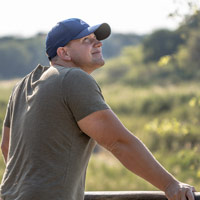 Joschka Voss, a 33-year-old medical doctor from Niederkassel, Germany, has a deep passion for travel, particularly in wild and untamed places, with a special affinity for exploring Africa. His love for these destinations developed during childhood trips to remote locations like Kgalagadi Transfrontier Park, Okavango Delta, South Luangwa National Park, Hwange National Park, and more. Over time, Joschka’s interest in wildlife photography grew, and he self-taught himself through online resources and tutorials. He always carries his camera when on vacation, eager to capture captivating moments. Wildlife and landscape photography have become cherished hobbies and passions for Joschka, who relies on a Sony Alpha 7RV and Sony Alpha 9, along with the 200-600mm and 100-400mm lenses, for his wildlife photography endeavours.
Joschka Voss, a 33-year-old medical doctor from Niederkassel, Germany, has a deep passion for travel, particularly in wild and untamed places, with a special affinity for exploring Africa. His love for these destinations developed during childhood trips to remote locations like Kgalagadi Transfrontier Park, Okavango Delta, South Luangwa National Park, Hwange National Park, and more. Over time, Joschka’s interest in wildlife photography grew, and he self-taught himself through online resources and tutorials. He always carries his camera when on vacation, eager to capture captivating moments. Wildlife and landscape photography have become cherished hobbies and passions for Joschka, who relies on a Sony Alpha 7RV and Sony Alpha 9, along with the 200-600mm and 100-400mm lenses, for his wildlife photography endeavours.
Social: @joschka.voss

Judges’ comment:
Seeing giraffes in a sea of sand dunes warps the mind somewhat and makes us question our perception of where the world’s tallest terrestrial animal hangs out. Add to that the curves of their duelling necks against the wavy dune backdrop, and you have a photograph that catches the eye and asks questions.
Photographer and photo details – read more
“The early morning light in the African bush provides exceptional photographic opportunities. While searching for desert-adapted lions in the Hoanib riverbed, the sound of repetitive thudding drew our attention. We discovered two bull giraffes engaged in a fierce sparring match. They took turns ramming their heads and horns into each other or evading the blows, creating a violent yet dance-like spectacle. This intense encounter lasted nearly an hour, and the barren backdrop of the Namib desert enhanced the beauty of their patterned coats as the sun rose over the horizon. Witnessing this extraordinary scene was a truly unique and special experience.”
About photographer Mark Nissenbaum
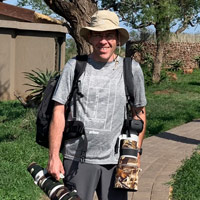 Mark, a Maxillofacial and Oral Surgeon originally from South Africa, moved to the USA in 2002, but leaving the African wilderness was heart-wrenching. To fill the void, he delved into photography, exploring nature in North America and Southern Africa, taking numerous courses and photo expeditions with professional wildlife and landscape photographers. Nature and landscape photography became his passion, and he finds joy in exploring the natural world with his wife and three sons and capturing its beauty. Mark believes life is an incredible journey, and his goal is to inspire others and foster a love for conserving and protecting our environment through his images.
Mark, a Maxillofacial and Oral Surgeon originally from South Africa, moved to the USA in 2002, but leaving the African wilderness was heart-wrenching. To fill the void, he delved into photography, exploring nature in North America and Southern Africa, taking numerous courses and photo expeditions with professional wildlife and landscape photographers. Nature and landscape photography became his passion, and he finds joy in exploring the natural world with his wife and three sons and capturing its beauty. Mark believes life is an incredible journey, and his goal is to inspire others and foster a love for conserving and protecting our environment through his images.
Social: @mark_nissenbaum
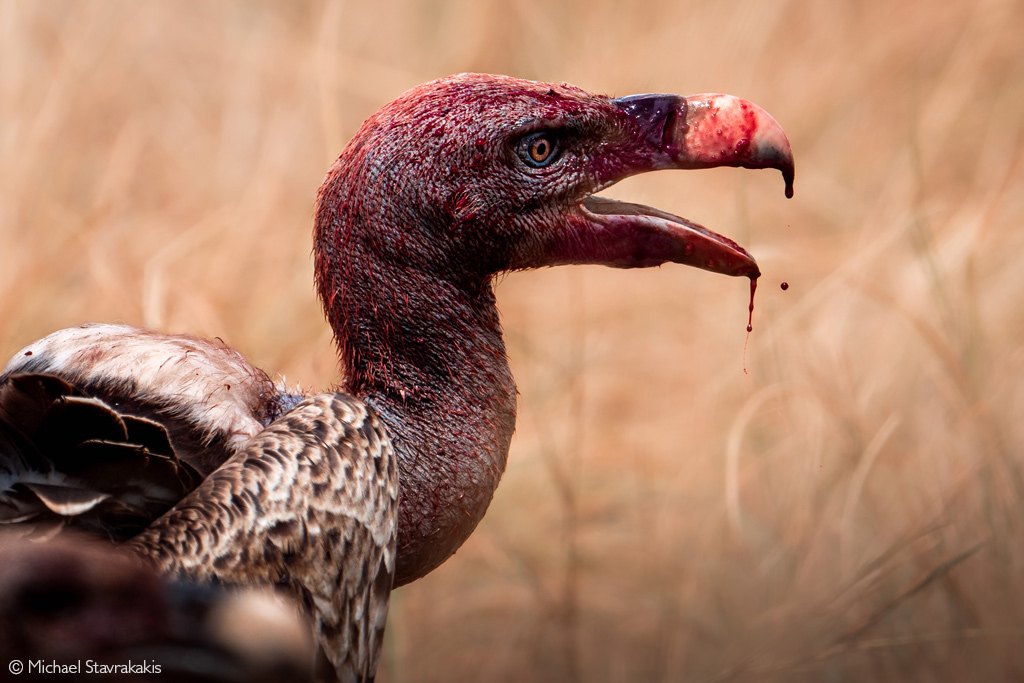
Judges’ comment:
We do love a bit of blood and gore to emphasise the brutal reality of wild Africa. And this is a fantastic study of why vultures have long necks with few neck feathers. Africa’s clean-up crew are under-appreciated by those who don’t get to see them in action; hopefully, this photo changes that!
Photographer and photo details – read more
“In the heart of the Maasai Mara during the wildebeest migration, we stumbled across a fresh kill and decided to wait for the lion pride’s return to resume their feeding. However, the lions did not reappear. Instead, the skies were soon filled with a flock of Rüppell’s vultures descending upon the carcass, transforming the scene into a frenzy of competition. Amidst the chaos of flying flesh and blood, one vulture stood out, thrusting its entire head into the carcass and emerging drenched in blood. Captivated by its determination, I followed its movements through the lens, aiming to capture a frozen moment of its feast.”
About photographer Michael Stavrakakis
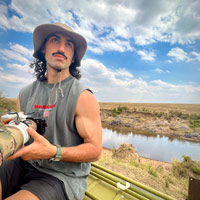 Michael Stavrakakis is an Australian photographer who quickly developed a deep passion for the people, culture, and wildlife of South Africa during his first visit in 2016. Mesmerised by the experience, he decided to make Johannesburg his home from 2017 – 2018, using his free time to explore neighbouring countries and national parks with his camera in hand. Ever since, he has regularly returned to the continent to spend time doing what he loves most – being immersed in the African bush and capturing the beauty of its wildlife.
Michael Stavrakakis is an Australian photographer who quickly developed a deep passion for the people, culture, and wildlife of South Africa during his first visit in 2016. Mesmerised by the experience, he decided to make Johannesburg his home from 2017 – 2018, using his free time to explore neighbouring countries and national parks with his camera in hand. Ever since, he has regularly returned to the continent to spend time doing what he loves most – being immersed in the African bush and capturing the beauty of its wildlife.
Social: @pics.stavtook
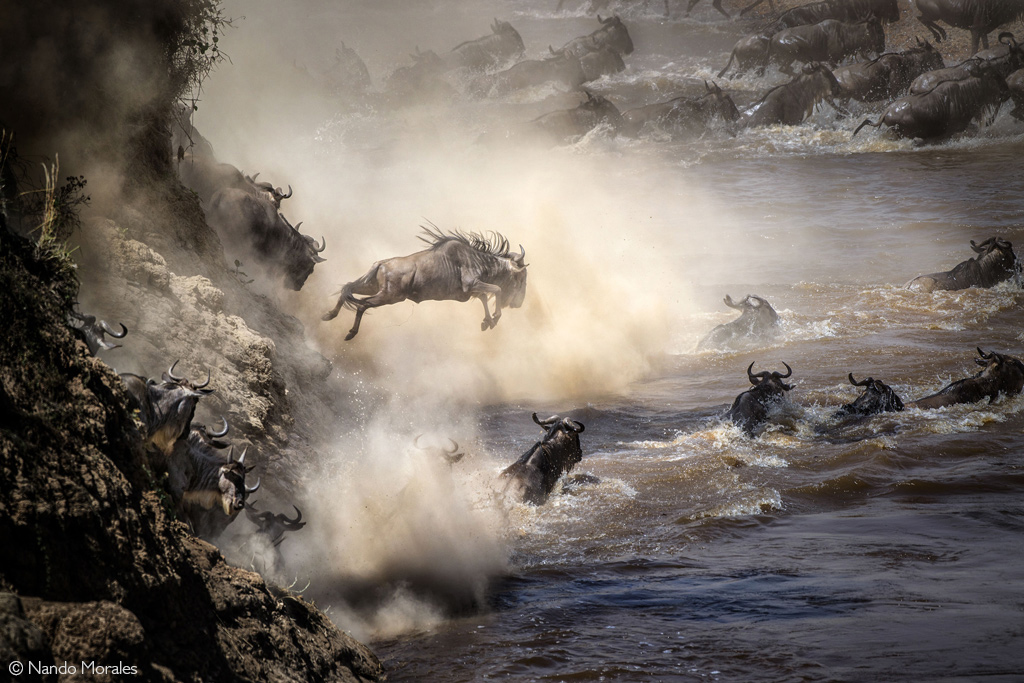
Judges’ comment:
This epic capture of that geronimo! moment as a wildebeest commits to the abyss celebrates the chaotic melee of the river crossings during the Great Wildebeest Migration. A wonderful capture of a frenetic split-second in time.
Photographer and photo details – read more
“‘One decides, the rest follow.’ The Great Migration is one of the greatest natural spectacles on Earth, and the crossings at the Mara River are chaotic, dramatic, and action-packed. Thousands of wildebeest gather on the riverbanks before one dares to take the first plunge. I remember watching documentaries and looking at photos of this moment, wondering if I would ever have the chance to witness and immortalise the scene. After several years and failed attempts, nature granted me that perfect unforgettable moment—the majestic leap of a wildebeest over the water I had always envisioned. I froze that instant in time, capturing the intensity of the event through the image, allowing us to feel the energy and survival instinct that drives the animals during their migration.”
About photographer Nando Morales
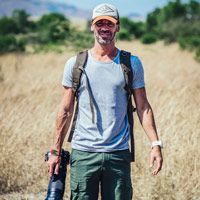 Nando Morales, born in 1982 in Spain, is a passionate photographer who grew up with a deep connection to nature and always showed a great interest in the animals and nature around him. He was gifted his first film camera as a teenager, and his love for nature merged with his newfound passion for photography. He has sought many opportunities to immerse himself in pristine landscapes far from civilisation, but it is in Africa, particularly Kenya, where he found the most magical corner. He always strives to immortalise moments that will profoundly impact the senses of viewers, conveying emotions and telling stories that take them on a journey, enriching their lives through visual experiences. His photographs have been selected for exhibitions, and he has been a finalist in several international photography contests. Although he doesn’t pursue photography as a professional career, he continues to enjoy every opportunity to capture special moments and tell stories through his images. His love for photography and his desire to improve and grow keep him seeking new challenges and opportunities.
Nando Morales, born in 1982 in Spain, is a passionate photographer who grew up with a deep connection to nature and always showed a great interest in the animals and nature around him. He was gifted his first film camera as a teenager, and his love for nature merged with his newfound passion for photography. He has sought many opportunities to immerse himself in pristine landscapes far from civilisation, but it is in Africa, particularly Kenya, where he found the most magical corner. He always strives to immortalise moments that will profoundly impact the senses of viewers, conveying emotions and telling stories that take them on a journey, enriching their lives through visual experiences. His photographs have been selected for exhibitions, and he has been a finalist in several international photography contests. Although he doesn’t pursue photography as a professional career, he continues to enjoy every opportunity to capture special moments and tell stories through his images. His love for photography and his desire to improve and grow keep him seeking new challenges and opportunities.
Social: @nandomoralesphoto

Judges’ comment:
The story is in the eyes. Is this the end for me? Grim determination shrouded by the realisation that life may soon end is written all over this youngster’s face as it struggles against an ancient foe. The crocodile, on the other hand, is all reptilian business as it tries to secure another meal. What a story this photograph tells!
Photographer and photo details – read more
“When I arrived at the scene, I noticed several baboons gathered along the dry riverbank of the Tsavo River. I spotted a baboon in a puddle and began to film its supposed bath. Little did I know what was about to unfold…Suddenly, chaos erupted. The baboons began screaming frantically as the baboon in the water tried to escape. It wasn’t a simple fight between baboons but a struggle between the baboon and the crocodile. Each time the baboon tried to move or break free, the crocodile pulled it back into the water, attempting to drown it. The water level in the puddle was low, allowing the baboon to keep its head above the water and breathe. In moments of stillness, the baboon demonstrated remarkable composure, seemingly aware that movement could increase the risk of being submerged in deeper water. It patiently waited for the right moment, inching closer to the edge where it could find more support on the ground. After several attempts, the baboon finally managed to break free. It re-joined the group, and they swiftly departed from the area. The baboon bore several wounds on its face, suggesting that the crocodile had seized it while it was drinking from the river. Throughout the entire sighting, I stood alone, witnessing the intense encounter and capturing this moment on camera.”
About photographer Nicolas Urlacher
 Nicolas Urlacher, a French photographer born in 1970, is currently based in Nairobi, Kenya. Despite starting his career as a teacher, his passion for images led him to explore various artistic fields, including cinema, photography, and painting. In 2013, Nicolas seized the opportunity to work as a Spanish teacher at the French School of Nairobi. His focus shifted from reportage to wildlife photography after capturing images of the Samburu and Maasai people. This transition allowed him to unite his passions for photography and nature, and he has dedicated most of his free time to a personal project: creating a bestiary showcasing Kenya’s wildlife. Nicolas emphasises the importance of field knowledge and species understanding in his approach to wildlife photography. He acts as his own driver and spotter in the savanna, valuing the solitude of the bush and the thrill of independently seeking and capturing the animals he wishes to observe.
Nicolas Urlacher, a French photographer born in 1970, is currently based in Nairobi, Kenya. Despite starting his career as a teacher, his passion for images led him to explore various artistic fields, including cinema, photography, and painting. In 2013, Nicolas seized the opportunity to work as a Spanish teacher at the French School of Nairobi. His focus shifted from reportage to wildlife photography after capturing images of the Samburu and Maasai people. This transition allowed him to unite his passions for photography and nature, and he has dedicated most of his free time to a personal project: creating a bestiary showcasing Kenya’s wildlife. Nicolas emphasises the importance of field knowledge and species understanding in his approach to wildlife photography. He acts as his own driver and spotter in the savanna, valuing the solitude of the bush and the thrill of independently seeking and capturing the animals he wishes to observe.
Social: @nicolas.urlacher.photographer
Website: www.wildlifeofkenya.com
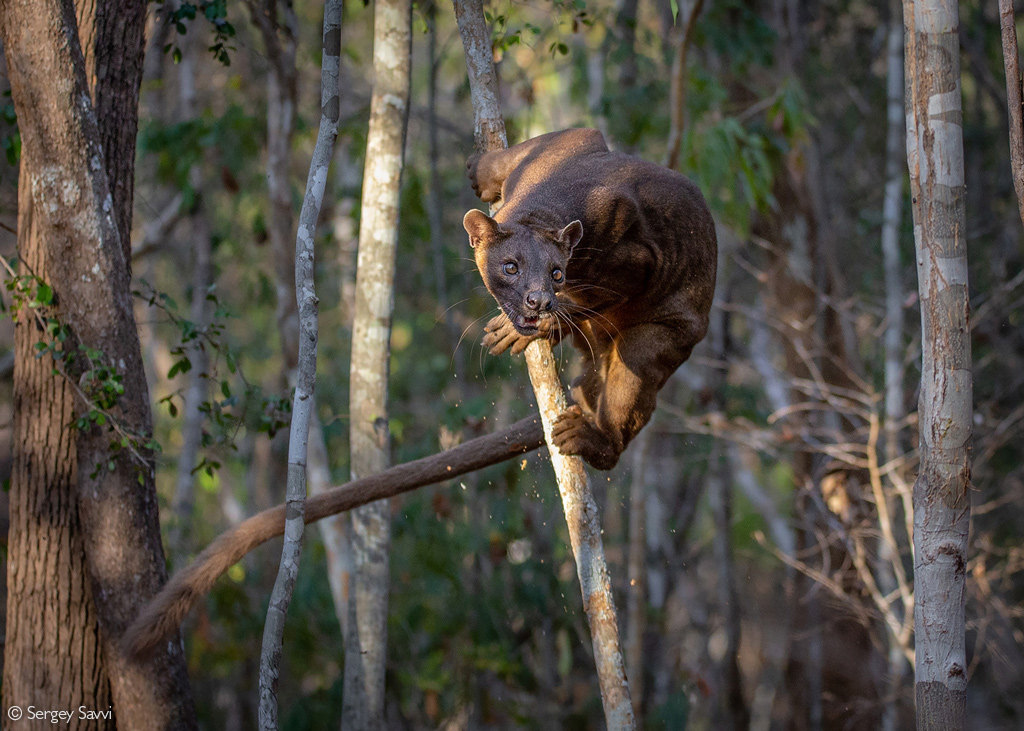
Judges’ comment:
The last thing lemurs see before their premature end? This photograph perfectly captures the athletic agility of the rarely encountered fossa, even in the arboreal dimension inhabited by lemurs, birds and other prey species. This arresting photo held our attention because of the unusual tree-level perspective.
Photographer and photo details – read more
“I was looking for lemurs near the camp and saw this predator, which had its own plan for them. It didn’t catch a lemur this evening, but I captured its furious intent. The fossa is the largest mammal predator in Madagascar and an endangered species. This animal was photographed in Kirindy Mitea National Park. About 4% of Kirindy Mitea National Park and the nearby Menabe Antimena Protected Area disappear yearly. According to scientific projections, the entire protected area will have vanished by 2050.”
About photographer Sergey Savvi
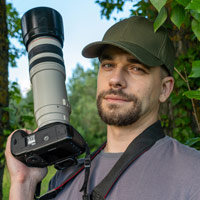 Sergey is an accomplished wildlife photographer recognised for his captivating images capturing the beauty of nature. With numerous awards and accolades, including participation in renowned exhibitions and festivals such as Golden Turtle, National Geographic, Sienna Awards, and more, Sergey’s work has significantly impacted wildlife photography. He conveys the natural world’s remarkable moments and diverse wonders through his artistry, inspiring others and promoting conservation awareness.
Sergey is an accomplished wildlife photographer recognised for his captivating images capturing the beauty of nature. With numerous awards and accolades, including participation in renowned exhibitions and festivals such as Golden Turtle, National Geographic, Sienna Awards, and more, Sergey’s work has significantly impacted wildlife photography. He conveys the natural world’s remarkable moments and diverse wonders through his artistry, inspiring others and promoting conservation awareness.
Social: @wildphotosapiens

Judges’ comment:
GoPros are often used for up-close-and-personal photographs – because the robust camera can be left in position while the operator retires to a suitable distance. This unusual capture of a perilously-close elephant’s foot with the rest of the herd following on grabs the eye and intrigues.
Photographer and photo details – read more
“Capturing elephants from unique angles on the ground has always intrigued me, especially when photographing their herds. I aimed to add my perspective to the collection of low-angle shots showcasing these magnificent creatures and their strong character. To achieve this, I opted for a discreet tool like the GoPro, allowing me to stay close without disturbing the elephants. The results of this experiment exceeded my expectations, leaving me in awe. The image revealed remarkable details, such as the massive foot—an often-overlooked feature symbolising their strength and resilience. It also showcased the elephants following their matriarch, set against a harsh environment of drought-stricken soil and the vast expanse of the sky. These elements combined to create a moment of intimate proximity that is otherwise hard to experience. Of course, GoPro loved sharing these!”
About photographer Vijayram Harinathan
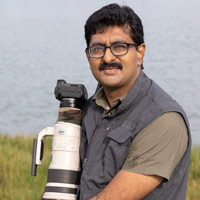 Vijayram Harinathan, a wildlife photographer hailing from Chennai, India, has been dedicated to documenting the wildlife of East Africa since 2016. His expeditions have spanned various parks in Kenya, with Samburu, Maasai Mara, Amboseli, and Tsavo being his personal favourites. With a longstanding fascination for birds, he embarked on a photography journey in 2010, which has evolved into a profound passion for capturing unique perspectives, characters, and behaviours in the wild. Notable for winning the NaturesBest Mkapa 2022 category, he utilises his images to convey conservation messages and inspire others to explore the wonders of nature. Beyond photography, Vijayram also takes pleasure in reproducing his works as fine art/giclée prints in his own home.
Vijayram Harinathan, a wildlife photographer hailing from Chennai, India, has been dedicated to documenting the wildlife of East Africa since 2016. His expeditions have spanned various parks in Kenya, with Samburu, Maasai Mara, Amboseli, and Tsavo being his personal favourites. With a longstanding fascination for birds, he embarked on a photography journey in 2010, which has evolved into a profound passion for capturing unique perspectives, characters, and behaviours in the wild. Notable for winning the NaturesBest Mkapa 2022 category, he utilises his images to convey conservation messages and inspire others to explore the wonders of nature. Beyond photography, Vijayram also takes pleasure in reproducing his works as fine art/giclée prints in his own home.
Social: @vijayramh
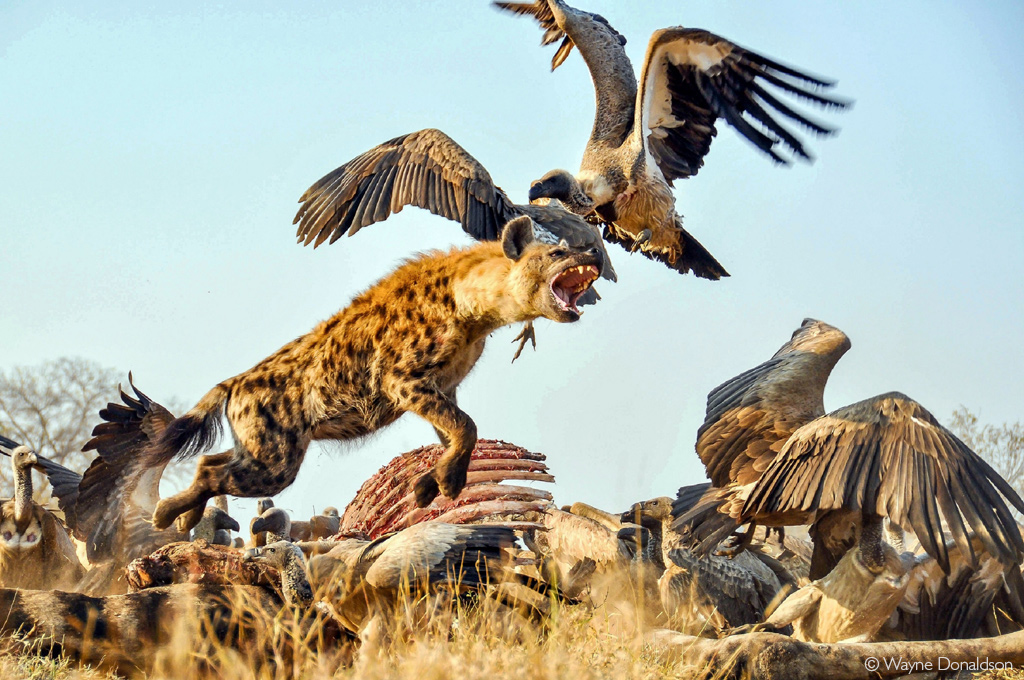
Judges’ comment:
How often do you see a flying hyena? This unusual ground-level perspective of the often-seen melee at a carcass grabs the attention and makes one wonder if they (the hyenas) ever manage to catch a vulture and what they would do with it if they did.
Photographer and photo details – read more
“A group of lions had been feasting on this giraffe carcass for several days. Once they left, the waiting hyenas and vultures eagerly seized their chance. Approximately 30 hyenas and over 100 vultures descended upon the scene, creating an incredibly interactive sighting. The hyenas were constantly on edge, fearing the return of the lions, and would temporarily retreat from the carcass, allowing the vultures to take over. However, the hyenas would quickly return, chasing off the vultures in a playful dance of dominance. Guided by my father’s expertise, we alternated positions under the Land Rover to capture low-angle shots. As luck would have it, I found myself in the right place at the right time, capturing a captivating image of a hyena leaping in the air in an attempt to catch a vulture. The entire experience unfolded in approximately two hours, etching an unforgettable memory in my mind.”
About photographer Wayne Donaldson
 Wayne was born in Zimbabwe but spent most of his childhood in the renowned reserves of the Sabi Sands and the Timbavati in the Greater Kruger. His father, the legendary ranger Pat Donaldson, has dedicated his life to wildlife conservation, allowing Wayne and his brothers the unique opportunity to grow up in the African wilderness. 1996 Wayne became a qualified tour guide and co-founded a business with his wife Catherine in 1998. With a specialisation in wine guiding and holding a FGASA level 2 Nature Guide certification, Wayne has honed his skills as a keen photographer. Currently, Wayne focuses on organising and leading privately guided safaris and tours in Southern Africa. When he’s not guiding others, he can be found capturing precious moments of his children on the beach or indulging his passion for fishing.
Wayne was born in Zimbabwe but spent most of his childhood in the renowned reserves of the Sabi Sands and the Timbavati in the Greater Kruger. His father, the legendary ranger Pat Donaldson, has dedicated his life to wildlife conservation, allowing Wayne and his brothers the unique opportunity to grow up in the African wilderness. 1996 Wayne became a qualified tour guide and co-founded a business with his wife Catherine in 1998. With a specialisation in wine guiding and holding a FGASA level 2 Nature Guide certification, Wayne has honed his skills as a keen photographer. Currently, Wayne focuses on organising and leading privately guided safaris and tours in Southern Africa. When he’s not guiding others, he can be found capturing precious moments of his children on the beach or indulging his passion for fishing.
Social: @wildtrackersafaris

To comment on this story: Login (or sign up) to our app here - it's a troll-free safe place 
![]()




